Ecclesiastical embroidery is one of my favorite categories of hand embroidery – I love the combinations of goldwork and silk and shading seen in old samples of hand embroidery worked for the beautification of churches. I was cleaning out some picture files to make space on my computer, when I came across these photos and thought they would be appropriate to post today as good examples of figure embroidery, goldwork, and silk. I hope you like them!
These are two examples of different representations of the Sacred Heart, worked in gold metal threads and silk. The embroidery is perhaps not the finest ecclesiastical embroidery I’ve seen, but there are some notable points to both pieces.
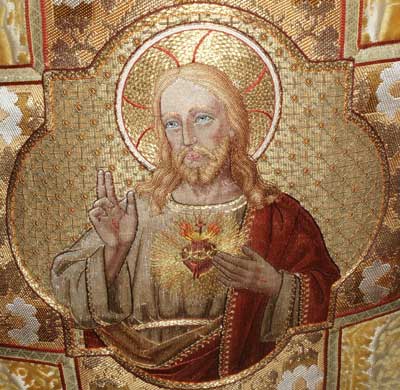
A front view of this image does not show it off well, in my opinion, but there are elements of it that I think are really exquisite. For example, the effect of “light” around the Sacred Heart is very nice. Also, I like the gold on the robes. But the image looks better, I think, when seen from the side, which is curious.
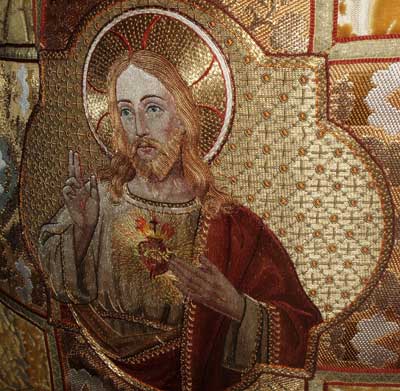
This is the same image from the side. I think the face is more appealling from this angle.
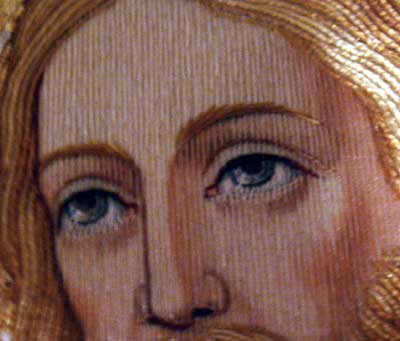
I think the eyes are beautifully worked. Close up, they are even more impressive.
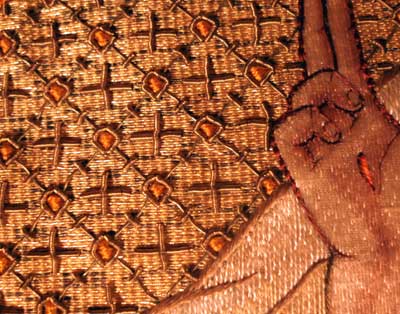
The image is set on cloth of gold, which is enhanced by a pattern worked in gold purl.
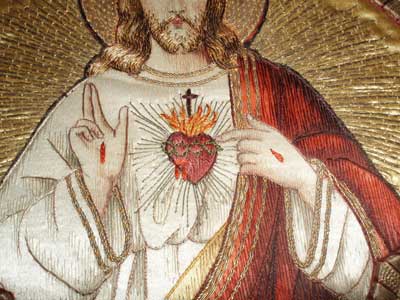
This is a different image of the Sacred Heart, and it is, in my opinion, not quite as nice as the one above. But the techniques are completely different. In the image above, the robes – in fact, the entire figure – is embroidered. In this image, the figure is made of appliqued fabric, which has been stitched over where shading is desired, to give the “look” of embroidery without the labor-intensiveness of hand embroidering the entire image.
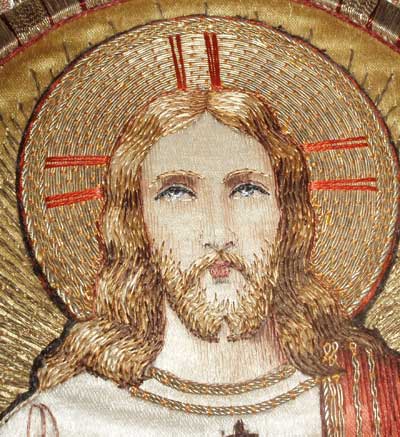
The face on this image is solid flesh colored fabric. The shading is achieved by stitching darker flesh tones only where shading is desired. Sometimes, such pieces would actually be painted. The details of the face, for example, would be painted onto silk. The shading was then achieved primarily by the paint, and lines of stitches would be added to enhance the shading. But on this particular piece, the background of the face is flesh-colored silk which is not painted.
Anyway, I like looking at pieces like these to determine techniques and to get ideas. I hope you enjoyed seeing the photos!
Have a great weekend!







Mary, I thoroughly enjoyed looking at the embroidery and the images. Thanks for a great post.
I like the hair on both samples.
I, too, like the glow around the Sacred Heart in the first and the background patterning. The halo has a nice quality as well.
Where did these come from?
Thank you for sharing!
Wow! How different, on the first piece, the expression in the eyes looks depending on the angle!
The fourth picture down, the small crosses and the bits that look like set jewels? Are the cross shapes, and the “settings” for the satin stitch jewels, examples of couching?
The halos on both pieces blow my mind…Sure would love to see them up close!
Thanks for sharing, Mary. -Jeannine
These are beautiful. Those eyes are just incredible!!!! Thank you so much for posting inspiring pics like these.
What are the orange centers in the purl pattern?
And what are the rays on the second Sacred Heart made of?
-Christiana
I love the diaper pattern too. Can you tell us more about it’s construction?
Thanks for a lovely post
Hey, Mary, Thanks for posting these. Great pictures. I’d be interested to know where they are from. Regarding the background on the top: looks to me like laid and couched #2-#4 gold. Then a lattice was laid, one way then another with the purl, junctions tied down with silk (small orange in the middle of the little squares), then the small squares were applied. Could you tell if they couched the purl lattice? Seems like that is the only way it could be done. Thanks again for posting. Anneg
Hi, Annneg –
I think the purl is sewn on in a normal bead fashion, from what I can tell, with the exception of the following:
1. around the orange centers, where it is sewn on like a long bead in two pieces, starting at the top or bottom point of the diamond shape, and couched on the side to pinch and turn it around the corner.
2. perhaps the vertical bar on the middle cross shape, which on some, looks like it is couched on each side of the horizontal bar it passes over – although on others, it is a smooth long purl that just lays over the horizontal bar – no kinks or anything that makes it look couched through.
The lattice connections between the diamond shapes are a smaller sized purl, extending from each diamond’s edge. The lattice pieces are crossed over in the middle by the fatter purl that divides the half-way break in the pattern. From zooming in on the close-ups, it doesn’t look to me as if the purl for the lattice extends in long lengths, but rather that they end and begin at the edge of each diamond shape.
You’re right about the background – it is certainly not cloth of gold! Whoops! That’s what I get for assuming. I just took a better look, zooming in on a close-up. It looks to me like a line of couched gold-colored silk (the couching makes the bundle of flat silk a little poofy) alternating with lines of couched passing thread.
Wow. Funny when you starting looking up close at these things – it’s like putting together a little “whodunnit” – only it’s a “howdunnit.”
I just looked closely at the halo, for someone who made a comment. It is actually pretty easy to do. The gold, usually a #4 or more, is couched in pairs. Since I do Japanese embroidery, I use a pair of koma, square sided spools. You make a good outline of the circle, or 1/2 circle, then couch the first pair onto the line. Each successive line, you just have to make sure you get close and you brick the couching, 2mm apart. Mary, any other comments? Anneg